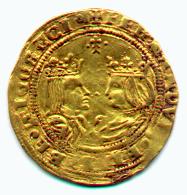|


| |

2 Excelentes of Ferdinand and Elizabeth
|
2 Excelentes
de Ferdnando e Isabel
|
|

|
|
Ferdinand and
Elizabeth at Medina del Campo, all the laws of this official
year up to June 13, 1497. |
D. Fernando. i D. Isabel en Medina del Campo, todas
las leyes de este titulo año 1497, a 13 de Junio. |
|
Law II
Furthermore
we ordered, and we commanded, that in each one of these mints
another silver money, that is called real, to be cut out, and with weight
of sixty seven reales in each Mark*, and not less; and fineness of
eleven-twelfths, and four grains, and not less; these made into reales,
half reales, and quarter reales, eighth reales, which all are kept one to
one, because they are of equal weight, and of the silver make a third in
reales, and another third in half reales, and the other third in
quarter reales, eighths are half (a quarter real), and which the eighths
are to be square, and that on the reales put on one side our Royal arms,
and on the other side the yoke, which is the device of me the King, and
the arrows device of my Queen, and that says in legend that continues on
both sides Ferdinandus, et Elisabeth, Rex, et Regina Castellae, et
Legionis, et Aragonum, et Siciliae, et Granatae or as much as will
fit, and on the square eighths an F with a crown above, and on the other
side a Y with a crown above and around them the legend, as with the reales
which have our devices, one on one side, and the other one on the other
side; and around them the legend as with the reales.
Law
XXXVIII
Furthermore,
because, if money of gold, or of silver is found to be under weight, the
assayer will be known by his assay mark on it, we ordered and we commanded
that each assayer signs each piece with his mark, by which it is known who
did the assay on that coin, because if the fineness is found low, we know
which assayer with whom to take corrective measures in return: and we
commanded to the engravers of each one of these mints to place in the
dies the mark that the assayer will indicate to him in the presence of the
mint scribe, so that he records it in his book, and that way knows the
assayer's mark and who will be punished if one is found to be deficient.
* the Mark was a German standard weight, in Spain the
weight varied by a slight amount, on average it was equal to 230.1232
grams. |
Lei II
Otrosi
ordenamos, i mandamos, que en cada una de las
dichas Casas de Moneda se labre otra moneda de plata, que se llame reales,
de talla, i peso de sesenta y siete reales en cada marco*, i no menos; i
de lei de once dineros, i quatro granos, i no menos; i que destos se
labren reales, i medios reales, i cuartos de reales, i ochavos de reales,
los cuales todos sean salvados uno á uno, porque sean de igual peso, i
que de la plata se labre el un tercio de reales, i el otro tercio de
medios reales, i el otro tercio se labre de quartos, i ochavos por mitad,
i que los ochavos sean quadrados, i que en los reales se pongan de la una
parte nuestras armas Reales, i de la otra parte la devisa del yugo de mí
el Rei, i la devisa de las frechas de mi Reina, y que diga en derredor
continuando en ambas partes: Ferdinandus, et Elisabeth, Rex, et Regina
Castellae, et Legionis, et Aragonum, et Siciliae, et Granatae, o lo
que dello cupiere, i en los ochavos, quadrados del un cabo una F i encima
una corona, i del otro cabo una Y i encima una corona i sus letras en
derredor, segun que en los reales le pongan las nuestras devisas, una de
una parte, i otra de la otra parte; i al rededor sus letras segun que en
los reales.
Lei XXXVIII
Otrosi,
porque, si alguna moneda de oro, ó de plata
se hallare falta, se sepa qual Ensayador hizo el ensai della, ordenamos i
mandamos que cada Ensayador haga poner en cada pieza una señal suya, por
donde se conozca quién hizo el ensai de aquella moneda; porque si fuere
baxa lei, sepamos á quál Ensayador nos avemos de tornar: i mandamos a
los Entalladores de cada una de las dichas Casas que pongan en los cuños
la señal, que él Ensayador le señalare por ante el Escrivano de la
Casa, para que lo asiente en su libro, i por allí se conozca la señal de
que Ensayador es i el que errare sea punido con esta prueba.
* el marco
castellano con valía variable en distintas reigiones, aproximadamente
230.1232 gramos. |
  |
|
Excerpts of the
laws taken from: Heiss, Aloiss.
1865 - 1869 Descripción general de las monedas hispano-cristianas
desde la invasión de los árabes. Madrid: Impreso de M. Galiano. 3
tomos. Tomo Primero, páginas 323-4.
|
| copyright
2003 |
|
|
